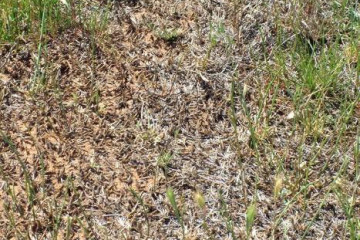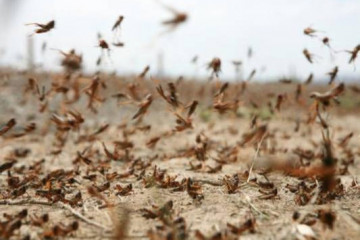Australian Pulse Bulletin
Impact of locusts on pulse crops and grain quality
Key points
- Locusts pose more than just a physical threat to pulse crop yields and quality.
- Controlling locusts before harvest is imperative to ensure marketable quality grain and to ensure successful delivery.
- Pulse growers need to make contact with their receival agent well in advance of harvest to discuss probable industry attitudes to high locust inclusion in the grain sample.
- Both receival agents and marketers may reject grain with high locust inclusion despite the sample technically meeting the receival standard for field insects.
- Grain staining, slimes and objectionable odours may arise from squashing live locusts during harvest. This material is difficult, if not impossible to remove.
- Objectionable material and odours in the sample will result in the product being rejected at the receival point.
- Only permitted chemicals are to be used for control of locusts.
- Maximum residue limits apply and grain samples may be collected and analysed for compliance with regulatory and market requirements.
Locusts can potentially affect pulse crops in all Australian grain production regions. Locusts have the potential to damage green crops and can have significant impact on yield and delivery quality of pulse grain.
-

Locust hatchlings cause the most damage when they form feeding bands that move across the land eating anything that is green.
-

Locust swarms can travel long distances on the wind. Landholders are required to report locust activity.
Effect on growing crops
While it is well known that cereals are particularly vulnerable to locusts, the susceptibility of the various pulses is uncertain, but we must assume that they could be attacked while they remain green. It is important to note that:
- Established green crops are susceptible to damage by adult locusts but tend to be avoided by hoppers (immature locusts), although crop edges can be damaged and may warrant a perimeter spray.
- Locusts cause little damage to crops that have dried off, but crops that are beginning to dry down when locusts begin to fly are still susceptible to attack.
- Even slight damage to pulse crops that have a high grain value or are destined for specific export markets could justify the cost of control.
- As a general rule, hopper and adult numbers should be closely monitored, and if any damage is seen, then spraying should be commenced immediately.
- Comply with label directions for the chosen insecticide and pay particular attention to withholding periods (WHP) for harvest/windrowing or swathing, and for grazing/fodder.
Impact on pulse deliveries
The receival and export farmer dressed standards for most pulses have a tolerance for a maximum of 0–2 grasshoppers or locusts in a 200 g sample (or max. 4 in 400 g), dead or alive. For grasshoppers and/or locusts, six legs, three body parts or two wings or part thereof, constitutes one entire insect respectively. More than one of the same body part constitutes greater than one insect.
Storage and handling companies and marketers may refuse to receive grain into current market grades if they find unacceptable levels of locusts present, despite the sample technically meeting the standard for field insects.
In years of high grasshopper and locust density at harvest, discuss the potential of contamination with your prospective storage agent or marketer before harvest.
Apart from the issue of physical presence of locusts in grain samples, there is an added quality concern, similar to snail contamination. Slime and intestine contents from live locusts squashed during harvest are major concern. Seed staining is likely, and there is added potential for objectionable odours to occur. Any slime or odour associated with the grain will deem the grain unacceptable to market as there is a nil tolerance of odour and contamination with slime material.
The potential contamination of the grain will usually warrant the implementation of control measures from crop emergence, through spring growth and up to harvest. Only a few chemicals are registered for control of locusts in pulse crops. These must be used according to product labels and the required withholding periods to ensure that maximum residue limits are complied with. Using chemicals off-label is an offence and places the marketing of affected pulses in jeopardy.
Reporting infestations
Landholders and land managers are expected to report hatchings and to control infestations on their own property, unless control of the density is beyond their means or it is public land where activities may need to be taken by specific government agencies. Reports are to be made to the biosecurity agency in your state or to the Australian Plague Locust Commission.
Management options
The decision on how locusts in crops are best managed is affected by a range of factors including:
- Growth stage of the crop, i.e. is there any green plant material or has the crop completely dried off?
- Ability to harvest early—desiccation may be an option to advance harvest.
- Delivery standards required for the specific pulse—discuss requirements with potential buyers.
- Risk to market from pesticide residues—WHP for windrowing/swathing is the same as harvest.
- Ability to clean physical locust contamination from harvested grain.
Control
The most effective and easiest way for landholders to control locusts is by ground spraying the hoppers when they have formed into dense aggregations called bands. This normally occurs from 1–2 weeks after hatching. The time available for controlling an outbreak is short with hoppers taking about 5 weeks to develop into swarming adults. Hoppers are most likely to hatch in pasture paddocks and along roadsides, fencelines and non-cultivated ground around the crop perimeter, but some hoppers may hatch from egg beds laid within crops particularly bare areas such as wheel tracks where tram lining is practiced.
It is critical in these situations that the correct insecticide is used to avoid residue issues. Australian grain produce must meet minimum residue levels (MRLs). Individual deliveries of grain will be tested for chemical residues, to detect the use of unapproved pesticides and to ensure that withholding periods have been followed.
- Only use an insecticide that is registered or has a permit for locust control in the specific pulse crop.
- Users must obtain, read and adhere to the conditions of APVMA permits prior to use.
- Follow label directions and pay attention to the WHP (withholding period) – Following pesticide application, the relevant withholding period MUST expire BEFORE cutting for hay, windrowing, harvest or undertaking of any similar operation.
- Plan well ahead in choosing the most appropriate product(s) to suit your situation as availability may become an issue as the season progresses.
- Be aware of the receival standards that apply to insect contamination (alive or dead) and grain damage from locust feeding.
- Be aware of nil tolerance for odour and taints that could arise from crushing locusts during harvest, handling or while in storage.
- Avoid inadvertent contamination of grain with other chemicals not used in pulses.

The above chart lists the active ingredients that are currently approved by the APVMA under permit (including permit number) or that have label registrations, along with the relevant withholding periods. Check the currency of the permits on the APVMA website by entering the relevant permit number from the chart.
See also
Key contacts
Disclaimer
Information provided in this guide was correct at the time of the date shown below. No responsibility is accepted by Pulse Australia for any commercial outcomes from the use of information contained in this guide.
The information herein has been obtained from sources considered reliable but its accuracy and completeness cannot be guaranteed. No liability or responsibility is accepted for any errors or for any negligence, omissions in the contents, default or lack of care for any loss or damage whatsoever that may arise from actions based on any material contained in this publication.
Readers who act on this information do so at their own risk.
Copyright © 2015 Pulse Australia
All rights reserved. The information provided in the publication may not be reproduced in part or in full, in any form whatsoever, without the prior written consent of Pulse Australia.
Last updated: 20 November 2015
